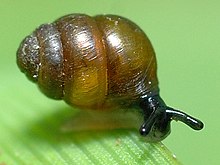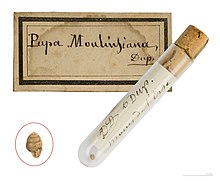Desmoulin's whorl snail
| Desmoulin's whorl snail | |
|---|---|
 |
|
| Vertigo moulinsiana | |
 |
|
| Vertigo moulinsiana Holotype MHNT | |
| Scientific classification | |
| Kingdom: | Animalia |
| Phylum: | Mollusca |
| Class: | Gastropoda |
| (unranked): | clade Heterobranchia clade Euthyneura clade Panpulmonata clade Eupulmonata clade Stylommatophora clade Orthurethra |
| Superfamily: | Pupilloidea |
| Family: | Vertiginidae |
| Subfamily: | Vertigininae |
| Tribe: | Vertiginini |
| Genus: | Vertigo |
| Subgenus: | Vertigo |
| Species: | V. moulinsiana |
| Binomial name | |
|
Vertigo moulinsiana (Dupuy, 1849) |
|
| Synonyms | |
|
|
Desmoulin's whorl snail, scientific name Vertigo moulinsiana, is a species of minute air-breathing land snail, a terrestrial pulmonate gastropod mollusc or micromollusc in the family Vertiginidae, the whorl snails.
This species was named in honor of the early 19th century French naturalist, Charles des Moulins.
This species lives in marshes and swamps.
Desmoulin's whorl snail lives in calcareous wetlands, where there are tall sedges, saw-sedge (Cladium mariscus), reed-grass (Glyceria maxima) or the reed Phragmites australis.
The distribution of this species is Atlantic (the part of the Palearctic area which is under the direct climatic influence of the Atlantic Ocean), and southern-European.
This small snail occurs across Europe as far north as southern Sweden.
Within Western Europe, only the populations in England (Great Britain) and Ireland are considered to be viable, although further populations exist in the Czech Republic (critically endangered, occupying White Carpathians Biospehere Reserve, Kokořínsko Landscape Protected Area and Southern Moravia), in Poland (critically endangered) and elsewhere in Europe (for example: Netherlands,France). Its conservation status in the Czech Republic in 2004-2006 is favourable (FV) in the report for the European Commission in accordance with the Habitats Directive. Its conservation status in Spain is endangered and it occurs in two localities only: near Estañá lake and near Lake of Banyoles.
...
Wikipedia

